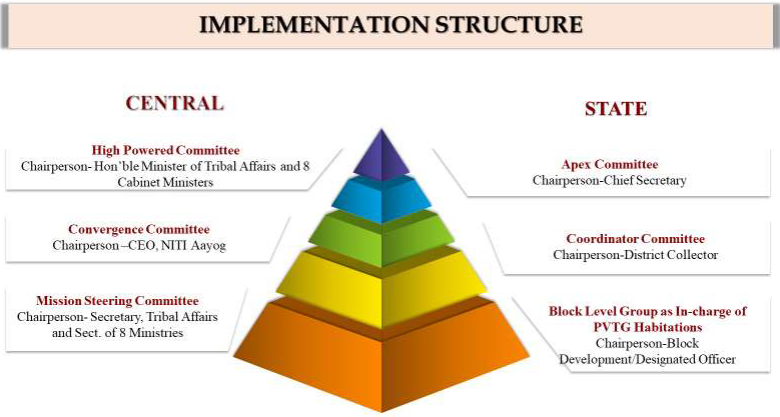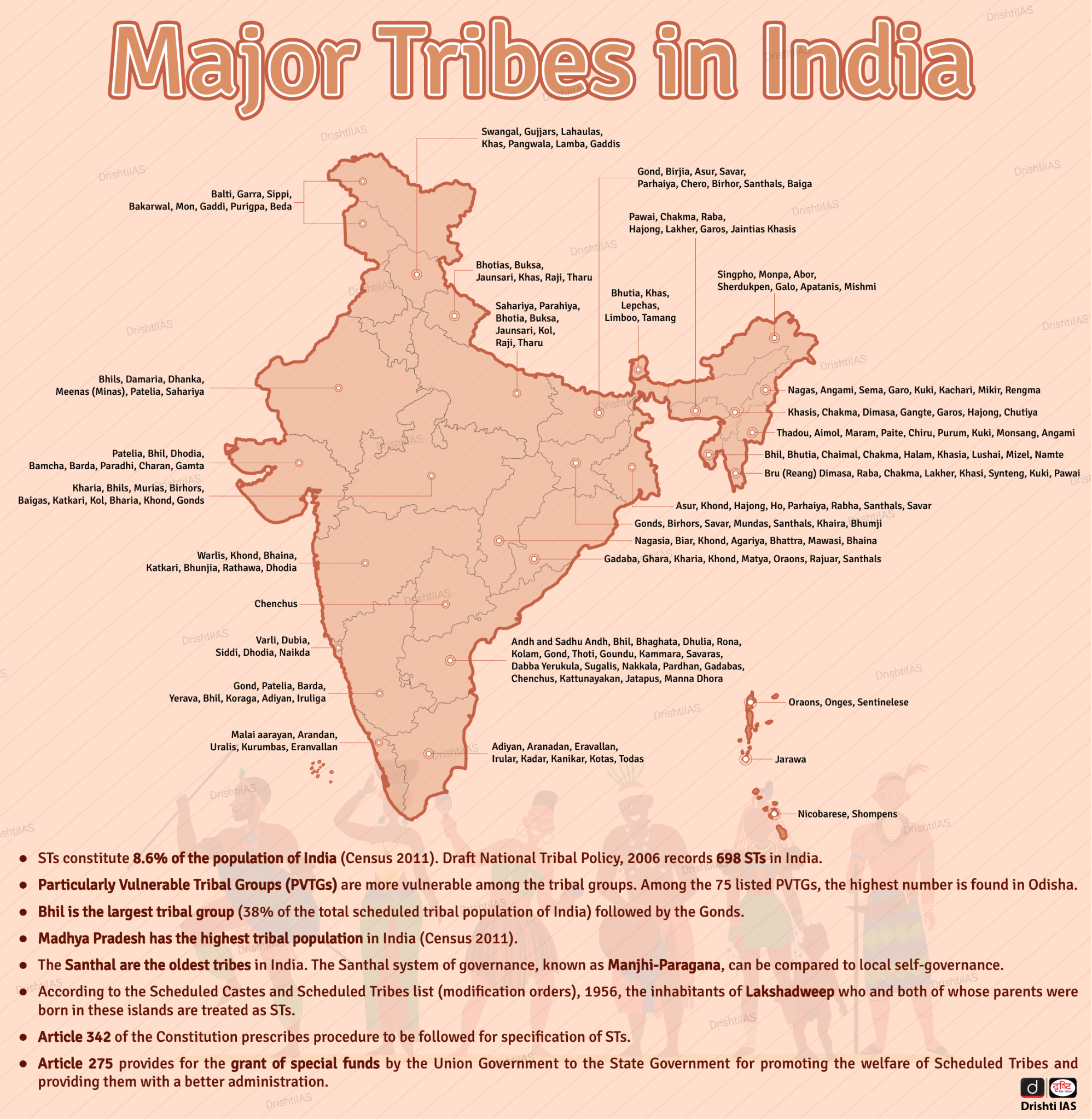PM-JANMAN Housing for PVTGs | 08 Mar 2024
For Prelims: Particularly Vulnerable Tribal Groups, PM-JANMAN Scheme, Janjatiya Gaurav Divas, Viksit Bharat Sankalp Yatra, PM PVTG Mission, PM Gati Shakti portal
For Mains: Sustainable Livelihoods For PVTGs. Welfare schemes for vulnerable sections of the population, Government Policies & Interventions
Why in News?
The housing component of Pradhan Mantri Janjati Adivasi Nyay Maha Abhiyaan (PM-JANMAN), aimed at providing housing for Particularly Vulnerable Tribal Groups (PVTGs), faces significant challenges hindering its smooth implementation.
What are the Challenges Hindering the implementation of PM-JANMAN?
- Data Discrepancies:
- Discrepancies have emerged between the data provided by the Centre and the figures identified by the states. This disparity in data poses a significant hurdle in accurately identifying potential beneficiaries.
- The Centre relied on the PM Gati Shakti portal for estimating the total population of 75 PVTG, resulting in varying figures.
- The estimates jumped from 28 lakh to 44.64 lakhs within a short span, indicating inconsistencies in data collection.
- State governments were given a limited timeframe to conduct their surveys, leading to rushed and incomplete data collection processes.
- States like Kerala, Madhya Pradesh, and Tripura have raised concerns about beneficiaries being left out due to discrepancies in the data.
- For example, Madhya Pradesh has found 50,000 additional eligible households outside the villages notified by the Centre.
- States like Kerala, Madhya Pradesh, and Tripura have raised concerns about beneficiaries being left out due to discrepancies in the data.
- Slow Progress:
- The simultaneous collection of beneficiary data and project implementation has led to delays in the housing component of PM-JANMAN. Out of the targeted 5 lakh houses, only 1.59 lakh have been sanctioned, significantly missing the initial target.
- Election Year Pressure:
- The scheme is being implemented at a rapid pace, especially with the upcoming General Elections 2024. The urgency to show progress may compromise thorough planning and execution, potentially affecting the quality and inclusivity of the housing distribution.
- Geographical Challenges:
- Identifying eligible beneficiaries in remote and inaccessible areas poses logistical challenges. Lack of infrastructure and communication networks in tribal regions may impede data collection efforts and delay the implementation of the housing scheme.
- Dynamic Population Dynamics:
- Tribal populations, especially PVTGs, often exhibit migratory patterns in search of employment and livelihood opportunities.
- This dynamic nature of population movement complicates the task of accurately estimating and identifying eligible beneficiaries, requiring adaptive strategies to ensure comprehensive coverage.
- Tribal populations, especially PVTGs, often exhibit migratory patterns in search of employment and livelihood opportunities.
What is PM-JANMAN?
- About:
- PM-JANMAN, launched on 15th November 2023, on Janjatiya Gaurav Diwas, focuses on 11 critical interventions through 9 ministries to improve the socio-economic welfare of PVTGs.
- PM-JANMAN comprises Central Sector and Centrally Sponsored Schemes to improve the socio-economic conditions of PVTGs.
- The scheme has a total outlay of Rs 24,104 crore to be spent over a three-year period, of which nearly 80% is only for the construction of houses and roads.
- An allocation of Rs 15,000 crore has been made for the next three years under the Development Action Plan for the Scheduled Tribes (DAPST) to implement the housing component of PM-JANMAN.
- Vision:
- PM-JANMAN envisions improving the socio-economic status of PVTGs by bridging gaps in health, education, and livelihoods.
- The focus is on enhancing basic infrastructure in PVTG communities, habitations, and families, aligning with existing schemes of nine Ministries/Departments.
- PM-JANMAN envisions improving the socio-economic status of PVTGs by bridging gaps in health, education, and livelihoods.
- Scope:
- The mission's primary scope is to comprehensively enhance the living conditions of PVTG by ensuring they have access to essential amenities and services. This includes:
- Foundational Features of PM-JANMAN:
- Inter-Ministerial Convergence:
- In a unique approach, 9 Ministries of the Government of India collaborate under the leadership of the Ministry of Tribal Affairs.
- Each Ministry oversees the implementation of its schemes while collectively ensuring comprehensive coverage and welfare of the most vulnerable tribal communities.
- In a unique approach, 9 Ministries of the Government of India collaborate under the leadership of the Ministry of Tribal Affairs.
- Alignment of Schemes/Programs:
- Existing norms of schemes within concerned Ministries are modified to address the specific needs of tribal communities.
- Revised guidelines are issued to ensure that the objectives of PM-JANMAN are effectively integrated into ongoing programs.
- Existing norms of schemes within concerned Ministries are modified to address the specific needs of tribal communities.
- Coverage of the Scheme:
- PM-JANMAN aims to reach 75 PVTGs residing in 18 states and 1 UT who continue to lag in socio-economic indicators of educational, health and livelihood.
- The focus is on providing holistic support to tribal communities across various domains, including health, education, and livelihoods.
- PM-JANMAN aims to reach 75 PVTGs residing in 18 states and 1 UT who continue to lag in socio-economic indicators of educational, health and livelihood.
- Identification of Gaps:
- Through physical surveys conducted by state governments, gaps in each intervention area are identified.
- Data is updated on the PM Gati-shakti Portal, enabling cross-verification by relevant Ministries and State Departments to ensure accuracy and completeness.
- Through physical surveys conducted by state governments, gaps in each intervention area are identified.
- Provision of Funds:
- The source of funds for each of the 11 interventions is the DAPST grants allocated to respective Ministries/Departments under their identified schemes covered by PM-JANMAN.
- Flexibility is provided under the DAPST mechanism to ensure dedicated funds availability for the successful implementation of the mission.
- The source of funds for each of the 11 interventions is the DAPST grants allocated to respective Ministries/Departments under their identified schemes covered by PM-JANMAN.
- Reward Mechanism:
- Performance evaluation is conducted through the ranking of districts based on monthly incremental changes in performance indicators.
- The purpose is to foster a sense of competition among district teams, with the top three districts and Ministries recognised and rewarded for their outstanding performance.
- Inter-Ministerial Convergence:
Note
- The DAPST is a strategy for tribal development in India. The Ministry of Tribal Affairs and 41 other ministries and departments allocate funds to tribal development projects under DAPST.
- These projects include education, health, agriculture, irrigation, roads, housing, electrification, and employment.
What are the other Initiatives for PVTGs?
Way Forward
- Implement a standardised data collection methodology to ensure data accuracy.
- Implement streamlined processes to expedite data collection and project execution without compromising quality.
- Engage tribal communities in the scheme's planning and execution to enhance inclusivity and effectiveness.
- Invest in infrastructure and communication networks in tribal regions to facilitate data collection and scheme implementation.
- Develop adaptive strategies to account for dynamic population movements among tribal groups and ensure comprehensive coverage of eligible beneficiaries.
- Provide training and capacity-building programs for stakeholders involved in data collection and scheme implementation to enhance efficiency and effectiveness.\\
UPSC Civil Services Examination, Previous Year Question (PYQ)
Prelims
Q.1 Consider the following statements about Particularly Vulnerable Tribal Groups (PVTGs) in India: (2019)
- PVTGs reside in 18 States and one Union Territory.
- A stagnant or declining population is one of the criteria for determining PVTG status.
- There are 95 PVTGs officially notified in the country so far.
- Irular and Konda Reddi tribes are included in the list of PVTGs.
Which of the statements given above are correct?
(a) 1, 2 and 3
(b) 2, 3 and 4
(c) 1, 2 and 4
(d) 1, 3 and 4
Ans: C
Q.2 Consider the following pairs: (2013)
| Tribe | State | |
| 1. | Limboo (Limbu) | Sikkim |
| 2. | Karbi | Himachal Pradesh |
| 3. | Dongaria Kondh | Odisha |
| 4. | Bonda | Tamil Nadu |
Which of the above pairs are correctly matched?
(a) 1 and 3 only
(b) 2 and 4 only
(c) 1, 3 and 4 only
(d) 1, 2, 3 and 4
Ans: (a)
Mains:
Q. What are the two major legal initiatives by the State since Independence addressing discrimination against Scheduled Tribes (STs)? (2017)
Q. Why are the tribals in India referred to as ‘the Scheduled Tribes’? Indicate the major provisions enshrined in the Constitution of India for their upliftment. (2016)



